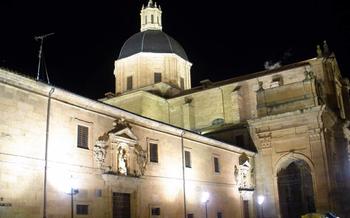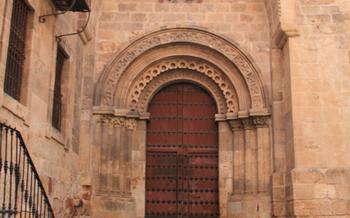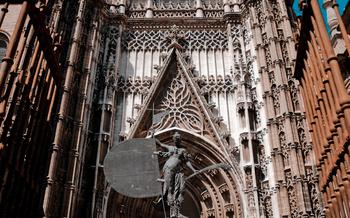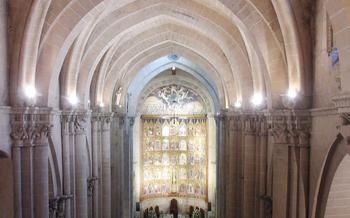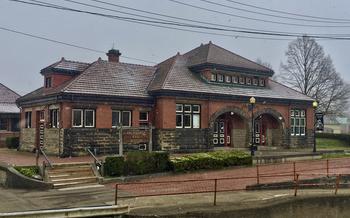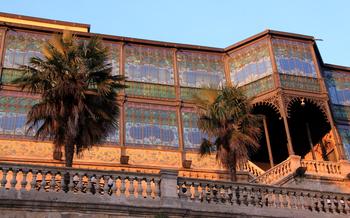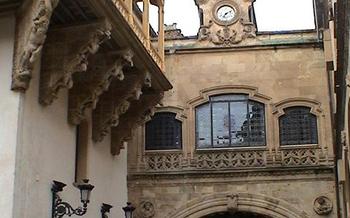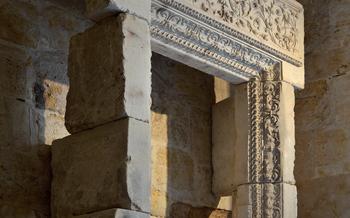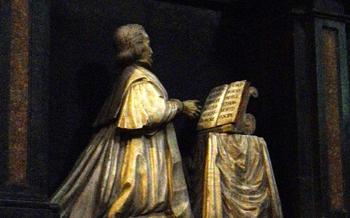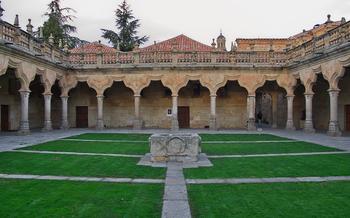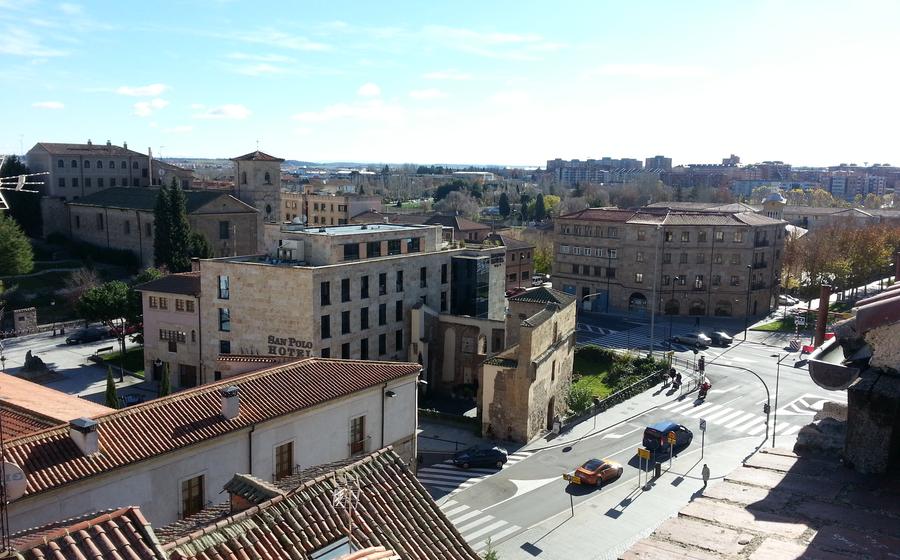
Capilla de San Ildefonso
- The Altarpiece: A Masterpiece of Renaissance Art
- The Tomb of Cardinal Deza: A Work of Renaissance Sculpture
- The Stained Glass Windows: A Symphony of Light and Color
- The Chapel's Ceiling: A Celestial Masterpiece
- The Choir Stalls: Intricate Woodcarvings
- The Sacristy: A Hidden Gem
- Restoration and Conservation Efforts
The Altarpiece: A Masterpiece of Renaissance Art
The Capilla de San Ildefonso's altarpiece, crafted in the 15th century, stands as a testament to the artistic prowess of the Renaissance era. Carved from alabaster, its intricate details and lifelike figures narrate scenes from the life of the Virgin Mary and the life of Christ. The altarpiece's central panel depicts the Coronation of the Virgin, flanked by smaller panels showcasing events such as the Annunciation, the Nativity, and the Adoration of the Magi.
Beyond its aesthetic beauty, the altarpiece holds immense historical significance. It represents the transition from the Gothic style, characterized by its elongated figures and pointed arches, to the more naturalistic and realistic style of the Renaissance. The altarpiece's harmonious composition, vibrant colors, and meticulous attention to detail reflect the artistic ideals of the period and showcase the skills of the master craftsmen who created it.
The Tomb of Cardinal Deza: A Work of Renaissance Sculpture
The Capilla de San Ildefonso is home to the impressive tomb of Cardinal Juan Rodríguez de Fonseca, also known as Cardinal Deza. Crafted in the Renaissance style, the tomb is a testament to the artistic prowess of its era. Carved from alabaster, the tomb features intricate details and lifelike representations.
Cardinal Deza, a prominent figure in the Spanish church and court, served as Archbishop of Seville and played a significant role in the conquest of the Canary Islands. His tomb, commissioned by his nephew, reflects his status and the esteem in which he was held.
The monument depicts Cardinal Deza in full regalia, lying in repose on a sarcophagus adorned with reliefs and statuettes. The four corners of the tomb feature allegorical figures representing virtues such as Prudence, Justice, Fortitude, and Temperance. The epitaph, inscribed in Latin, extols the Cardinal's virtues and accomplishments.
The tomb's artistic style showcases the transition from Gothic to Renaissance aesthetics, with its intricate carvings and lifelike details. The use of alabaster, a soft and translucent stone, allows for delicate sculpting and creates a sense of ethereal beauty.
The tomb of Cardinal Deza serves as a reminder of the significant role played by the church in Spanish society during the Renaissance period. It is a testament to the artistic and cultural achievements of the era and offers a glimpse into the life and legacy of a prominent figure in Spanish history.
The Stained Glass Windows: A Symphony of Light and Color
The Capilla de San Ildefonso is adorned with a remarkable collection of stained glass windows, creating an ethereal and vibrant atmosphere within the chapel. These windows are not mere decorative elements; they are masterpieces of artistry and storytelling, shedding light on the chapel's history, beliefs, and symbolism.
The stained glass windows depict a symphony of colors, patterns, and imagery, narrating biblical stories, the lives of saints, and scenes from the history of the university. The vibrant hues of blue, red, green, and gold dance through the intricate lead frames, casting a colorful glow upon the chapel's interior.
Artisans meticulously crafted these windows using traditional techniques, piecing together small fragments of colored glass to form larger compositions. The intricate designs showcase the skill and patience of the craftsmen, who brought these biblical and historical scenes to life with remarkable detail.
Each window tells a unique story, inviting viewers to contemplate the narratives depicted. From the Annunciation to the Crucifixion, the windows offer a visual journey through the life of Christ and the history of Christianity. They also showcase the university's connection to the church, as they feature scenes from the lives of prominent scholars and saints associated with the institution.
The Chapel's Ceiling: A Celestial Masterpiece
The ceiling of the Capilla de San Ildefonso is a breathtaking masterpiece that transports visitors to a celestial realm. Adorned with intricate artwork, the ceiling is a testament to the artistic prowess and deep religious symbolism of the Renaissance era. The ceiling's design features a stunning array of colors, patterns, and imagery, creating a harmonious and visually captivating composition.
At the center of the ceiling, one's gaze is drawn to a radiant depiction of the heavens, where clouds seem to swirl and celestial bodies dance in harmony. Angels and cherubs gracefully float among the clouds, their wings outstretched as if in a celestial ballet. The vibrant blue background evokes the vastness and mystery of the cosmos, while the golden hues of the angels and cherubs symbolize divine light and grace.
Interspersed among the celestial imagery are intricate geometric patterns and decorative motifs. These patterns, inspired by Islamic art, add depth and visual interest to the ceiling, creating a sense of symmetry and order. The use of geometric designs also reflects the mathematical and scientific knowledge of the Renaissance period, which sought to blend art and science in harmonious ways.
The ceiling of the Capilla de San Ildefonso is not merely a decorative element but a powerful symbol of religious belief. The depiction of the heavens, angels, and cherubs reinforces the idea of divine presence and the connection between the earthly and celestial realms. The ceiling serves as a reminder of the spiritual aspirations of the Renaissance faithful, who sought to transcend the physical world and embrace the beauty and wonder of the divine.
The Choir Stalls: Intricate Woodcarvings
The choir stalls in the Capilla de San Ildefonso are remarkable examples of intricate woodcarving craftsmanship. Arranged in two rows facing each other, these stalls were created in the 15th century and showcase the skill and artistry of the Spanish Renaissance.
-
Description: Each stall features a unique design, with elaborate carvings depicting biblical scenes, saints, and mythical creatures. The backs of the stalls are adorned with finely carved tracery, while the seats are decorated with intricate geometric patterns.
-
Artistic Style and Craftsmanship: The choir stalls exhibit a blend of Gothic and Renaissance styles, characterized by their attention to detail and naturalistic representation. The carvings display a mastery of perspective and depth, with figures rendered in three dimensions and adorned with intricate garments and accessories.
-
Symbolism and Iconography: The iconography of the choir stalls is rich in symbolism, reflecting the religious and cultural beliefs of the time. The carvings depict scenes from the Bible, such as the Annunciation, the Nativity, and the Crucifixion, as well as images of saints and allegorical figures representing virtues and vices.
-
Historical Context: The creation of the choir stalls coincided with the rise of humanism and the renewed interest in classical art and culture during the Renaissance. The carvings reflect this influence, incorporating elements of classical mythology and ancient Roman and Greek motifs.
The Sacristy: A Hidden Gem
Tucked away behind the main altar of the Capilla de San Ildefonso lies a hidden gem—the sacristy. Once used by the clergy to prepare for religious ceremonies, the sacristy now serves as a repository for precious artifacts and vestments.
The sacristy is a treasure trove of artistic and historical wonders. Its walls are adorned with intricate tapestries depicting scenes from the Bible, while its ceiling features a stunning fresco depicting the Assumption of the Virgin Mary. The room also houses a collection of gold and silver liturgical objects, including chalices, monstrances, and reliquaries, each piece a testament to the skill and craftsmanship of Spanish artisans.
One of the highlights of the sacristy is a beautifully carved wooden chest, believed to date back to the 15th century. The chest is adorned with intricate carvings depicting scenes from the life of Christ, and is said to have been used to store the vestments of the clergy.
Another intriguing feature of the sacristy is a small door that leads to a hidden staircase. This staircase once provided access to the upper levels of the chapel, but is now closed to the public. According to legend, the staircase was used by the clergy to escape in times of danger, such as during attacks or riots.
The sacristy is a fascinating glimpse into the behind-the-scenes workings of the Capilla de San Ildefonso. Its collection of artifacts and its unique atmosphere provide a sense of the chapel's rich history and religious significance.
Restoration and Conservation Efforts
Throughout its history, the Capilla de San Ildefonso has undergone several restoration and conservation projects to preserve its architectural integrity and artistic beauty. One of the most significant restoration projects was conducted in the late 19th century, focusing on repairing structural damage caused by age and weathering. During this time, the chapel's exterior was meticulously restored, including the cleaning and restoration of its intricate stone carvings.
In the 20th century, further restoration work was undertaken, particularly on the interior of the chapel. This included the cleaning and restoration of the altarpiece, the tomb of Cardinal Deza, and the stained glass windows. Conservators used specialized techniques to remove dirt and grime, restore the original colors and details, and protect the artworks from further deterioration.
In recent years, the Capilla de San Ildefonso has benefited from ongoing conservation efforts to ensure its preservation for future generations. These efforts include regular monitoring of the chapel's condition, preventive maintenance, and the use of advanced conservation techniques to address any emerging issues. By protecting and maintaining this architectural and artistic treasure, these restoration and conservation efforts contribute to the preservation of Spain's rich cultural heritage.
